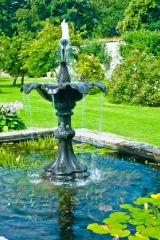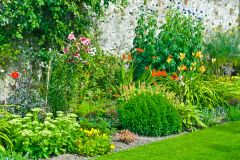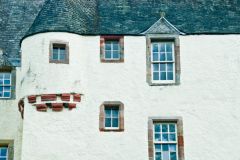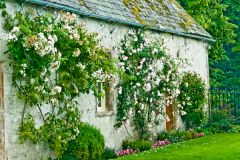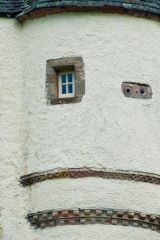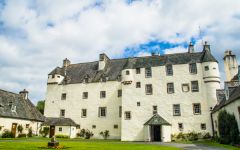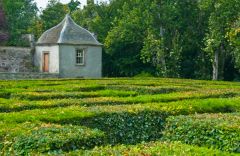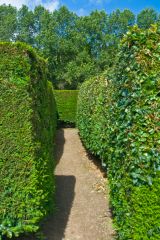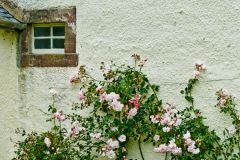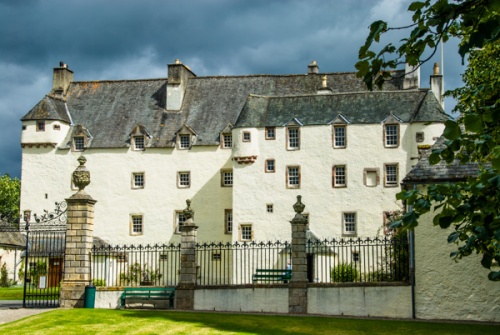
The name 'Traquair' tells a lot about the location of this ancient house near the confluence of Quair Burn and the River Tweed. The name comes from a combination of Celtic words meaning 'village on the winding stream', and indicates that there was a settlement here long before the coming of English-speaking Northumbrians to this area of Lowland Scotland.
The origins of the first house at Traquair are lost in the mists of time, but it must have established before 1107, when King Alexander I signed a royal charter here. That early date makes Traquair arguably the oldest house in Scotland in continuous habitation.
In King Alexander's time, the house at Traquair was used as a royal administrative centre, a court of justice, and a hunting lodge for Ettrick Forest. Numerous charters issued at Traquair still exist, including one issued in 1175 establishing a Bishop's Burgh which later grew to become the city of Glasgow.
Traquair had to be fortified during the turmoil of the Wars of Independence, and it was briefly seized by the English under Edward I, but when Robert the Bruce ascended the Scottish throne it was once more in Scottish hands.
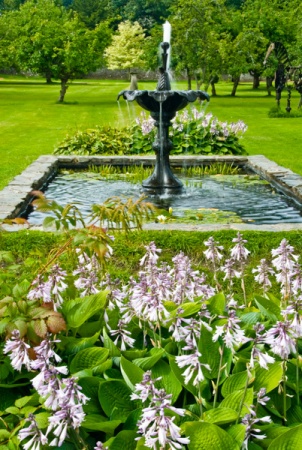
In 1460 James III gave Traquair to Robert, Lord Boyd, only to retrieve it and bestow it on his court musician, William Rogers. Rogers, in turn, held the estate for only 9 years before he sold it to the Earl of Buchan.
You'd have to say that Rogers was not a natural wheeler-dealer; he accepted a grand total of 70 marks for Traquair, roughly 3 pounds and 15 shillings. Not the best piece of business ever transacted in retrospect. In 1491 the Earl gave Traquair to his second son, James Stewart, and it has remained in the Stewart family since then.
The 4th Laird of Traquair was a major figure on the national stage; he rose to become Captain of the bodyguard to Mary, Queen of Scots. The queen, her husband Lord Darnley, and their baby son, the future James VI, visited Traquair in 1566. The queen's bed and the cradle that she used to rock the infant prince can be seen today.
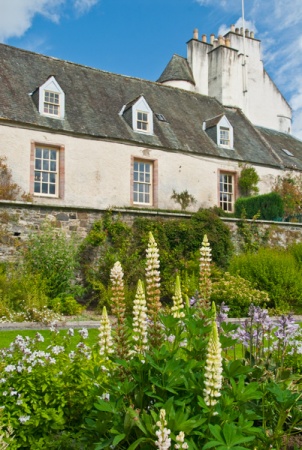
There's nothing notable in that, but Lady Seton was Catholic and was determined to bring her children up as Catholics too. She had a secret chamber built on the top floor of the house where the children could hear Mass daily, and access to a hidden escape stair was built behind a cupboard so that her priest could flee if necessary. The secret stairs remained in use until the Catholic religion was recognised under the Emancipation Act of 1828.
Throughout these years the house continued to take shape, gradually transforming from a medieval tower house into a comfortable country residence, suitable for one of the most influential families in Scotland. Part of that transformation came in the early 17th century when the 7th Laird had the River Tweed moved further from the house, which must have been a major engineering project!
In 1695 James Smith of Edinburgh designed flanking wings and erected a fanciful wrought iron gate in front of the house to create a courtyard effect. To the rear of the house, Smith built a double terrace with pavillions looking over formal gardens.
One of these pavilions now houses a camera obscura, which casts an image of the exterior view on the interior wall of the pavilion (it is quite an effect, I can tell you!). In the more than 3 centuries since Smith's work, the house has undergone no major changes at all.
Traquair and the Jacobites
Charles, the 4th Earl of Traquair, was a staunch supporter of the Jacobite cause, working in secret for the return of James II to the throne. He was cast into Edinburgh Castle for suspected involvement in a Jacobite plot. He was implicated in the failed rising of 1715.
His son, also named Charles, shared his father's Jacobite beliefs. In 1738 he built the Bear Gates, at the top of the long avenue that leads to the house. Bonnie Prince Charlie visited Traquair, passing through the new gates, and the Earl vowed that the gates would never again be opened until a Stewart king was crowned in London. Since the Second Jacobite Rebellion failed in 1745, the gates have remained firmly shut to this day.
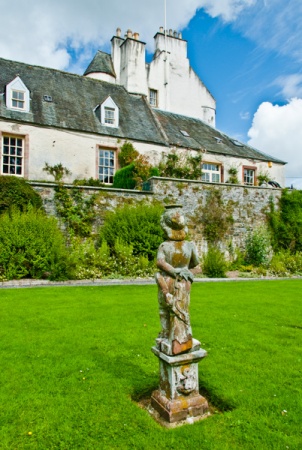
Subsequent Earls combined to lose much of the family's fortune through poor investments and gambling. Odds of reversing the family fortunes would have improved if the 8th Earl had married a rich heiress, but the Earl contrived to counter all his family's best efforts at matchmaking by putting stinging nettles in the beds of his potential mates. Ouch!
Traquair was eventually restored and opened to the public during the 20th century, mostly through the efforts of the 19th Laird, Frank Maxwell Stuart and his son Peter, the 20th Laird.
Highlights of the interior included the vaulted cellars, High Drawing Room, and the Kings room (part of the original 12th-century tower house). The state bed was used by Mary, Queen of Scots, and the cradle she used for her son James is at the foot of the bed.
On the upper floor is a museum hosting more Mary mementoes, including her rosary and crucifix. See the secret priest's room and hidden stairs, and a wonderful range of ornate staterooms.
There is a lovely mix of formal and woodland gardens behind the house, including a large hedge maze (it is a challenge to navigate, as I can attest). In the woodland nearby is an ancient circle of yew trees, thought to be amongst the oldest trees in Scotland, originally part of Ettrick Forest which surrounded the house.
Visiting Traquair
Traquair was one of the real highlights of our family tour of the Borders. The house is a gem, the gardens are endlessly fascinating, and history seems to ooze from every stone. It's no surprise that a house this old has such a fascinating array of stories to tell, and it is those stories, half-remembered through the passage of time, that help make Traquair such a delight. Highly recommended.
About Traquair House
Address: Innerleithen,
Borders,
Scotland, EH44 6PW
Attraction Type: Historic House
Location: 6 m (10 km) SE Peebles, at junction of B709 and B7062
Website: Traquair House
Email: enquiries@traquair.co.uk
Historic Houses Association
Location
map
OS: NT330354
Photo Credit: David Ross and Britain Express
HERITAGE
 We've 'tagged' this attraction information to help you find related historic attractions and learn more about major time periods mentioned.
We've 'tagged' this attraction information to help you find related historic attractions and learn more about major time periods mentioned.
Historic Time Periods:
Find other attractions tagged with:
12th century (Time Period) - 17th century (Time Period) - 18th century (Time Period) - Bonnie Prince Charlie (Person) - castle (Architecture) - Celtic (Architecture) - Edward I (Person) - Jacobite (Historical Reference) - James II (Person) - Mary, Queen of Scots (Person) - Medieval (Time Period) - Robert the Bruce (Person) - Stuart (Time Period) - tower house (Architecture) -
NEARBY HISTORIC ATTRACTIONS
Heritage Rated from 1- 5 (low to exceptional) on historic interest
Robert Smail's Printing Works - 0.8 miles (Museum) ![]()
Glebe Stone - 5.1 miles (Prehistoric Site) ![]()
Yarrow Stone - 5.1 miles (Prehistoric Site) ![]()
Cross Kirk, Peebles - 6 miles (Historic Church) ![]()
Neidpath Castle - 6.6 miles (Castle) ![]()
Bowhill - 7.6 miles (Historic House) ![]()
Stobo Parish Church - 9.3 miles (Historic Church) ![]()
Halliwell's House Museum - 9.7 miles (Museum) ![]()
